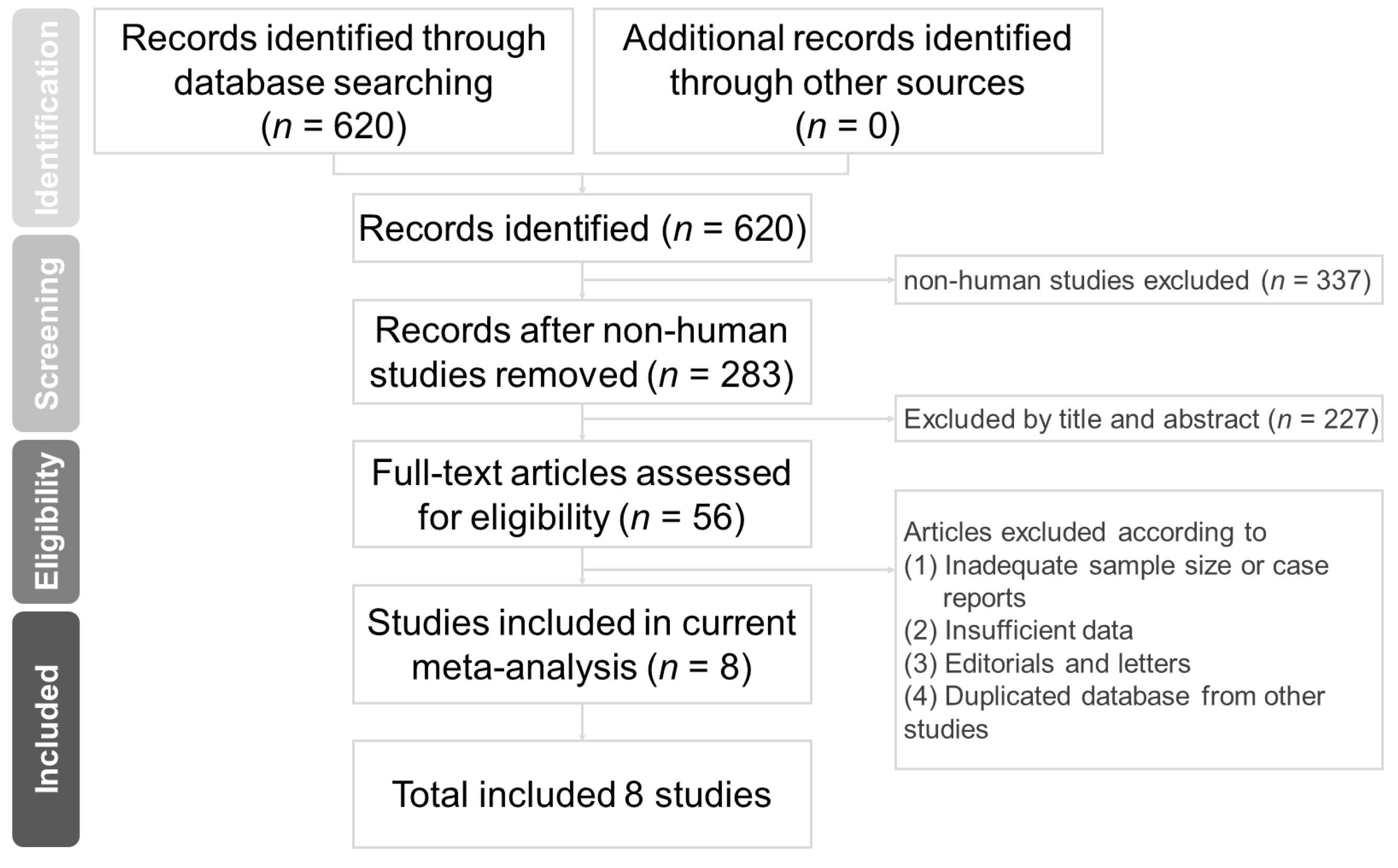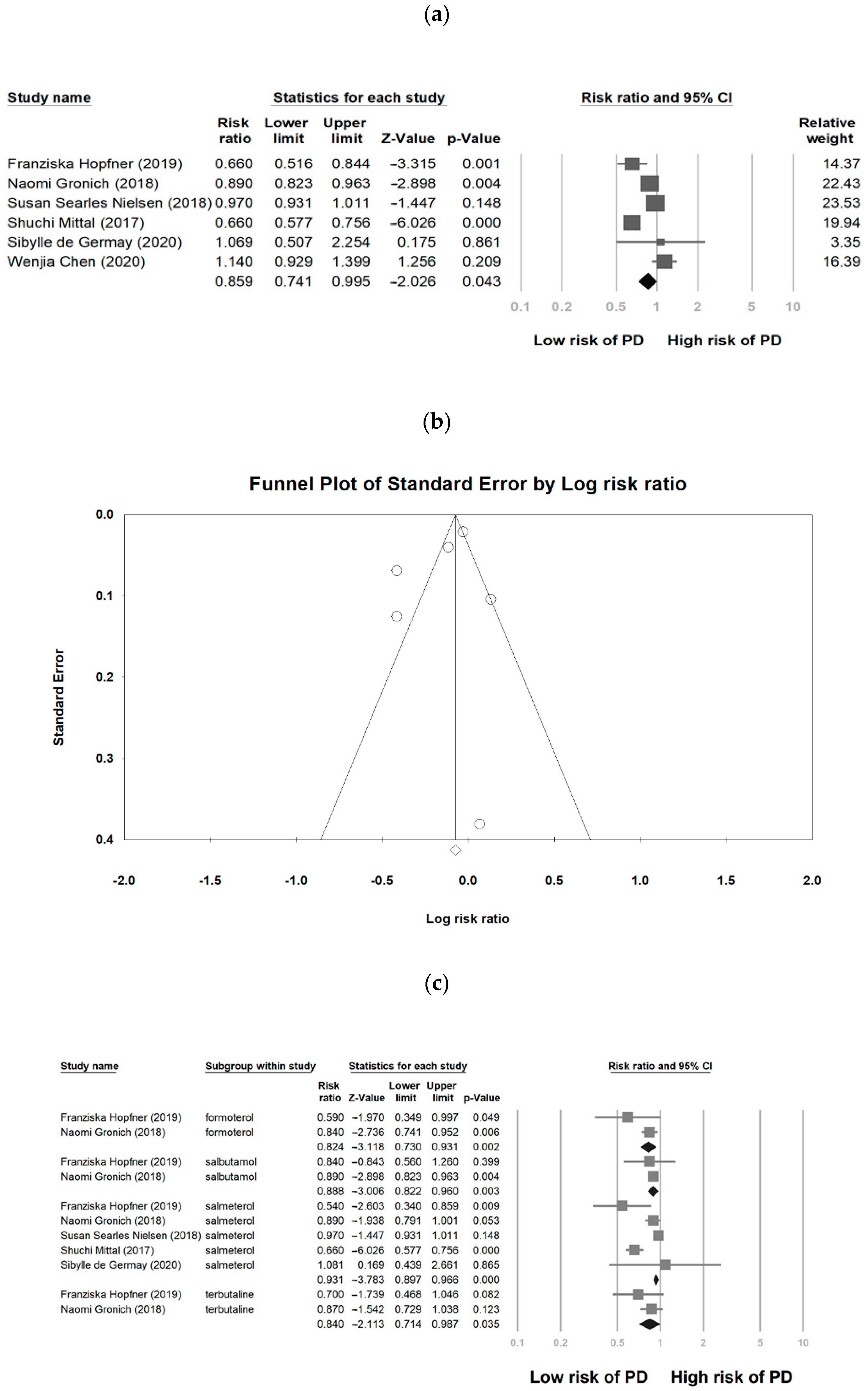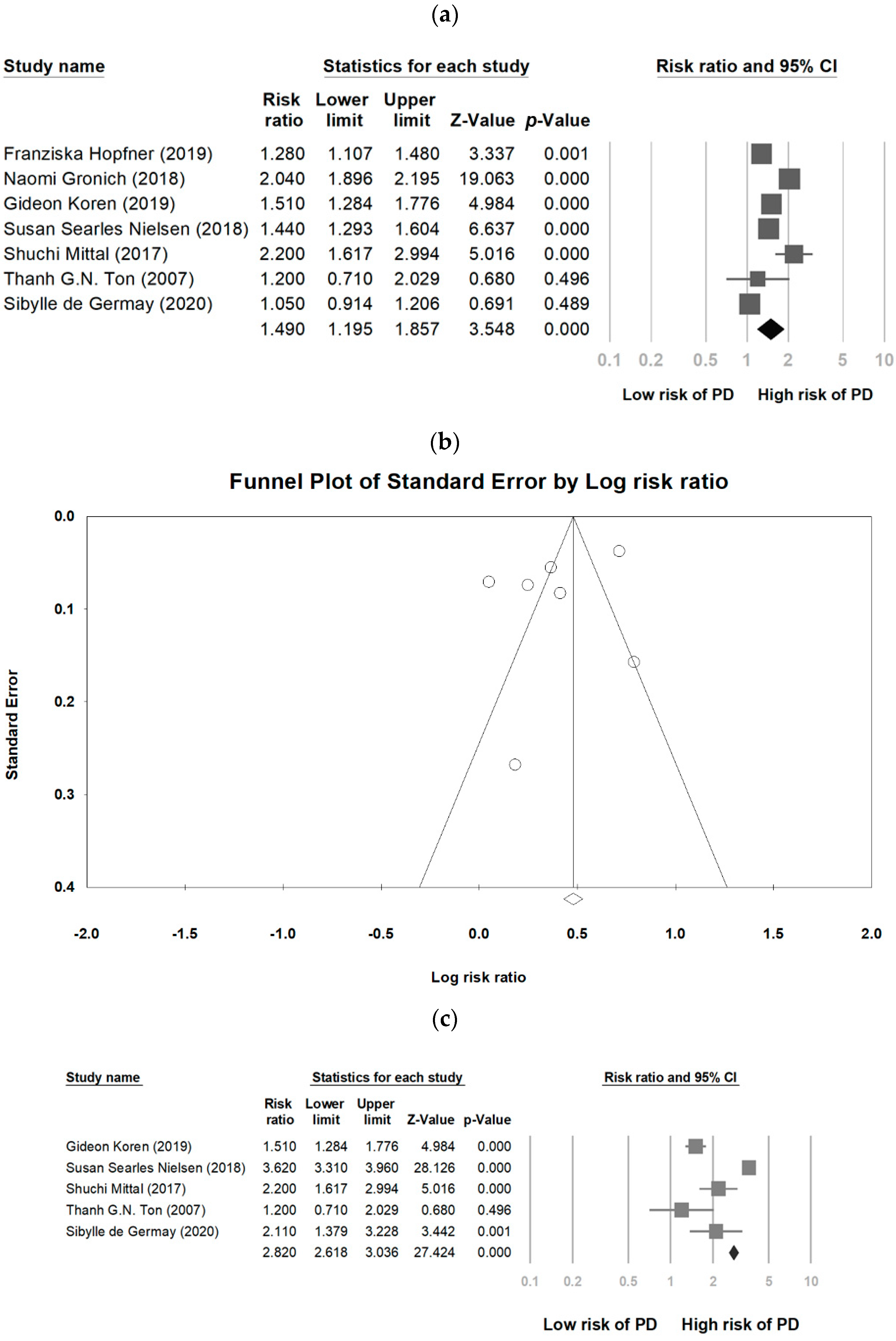Association between β2-Adrenoreceptor Medications and Risk of Parkinson’s Disease: A Meta-Analysis
Abstract
:1. Introduction
2. Methods and Materials
2.1. Literature Search and Screening
2.2. Data Extraction and Outcome Assessment
2.3. Statistical Analysis
3. Results
3.1. Search Results
3.2. β2AR Agonist and Risk of PD
3.3. β2AR Antagonist and Risk of PD
4. Discussion
5. Conclusions
Author Contributions
Funding
Institutional Review Board Statement
Informed Consent Statement
Data Availability Statement
Acknowledgments
Conflicts of Interest
References
- Feigin, V.L.; Nichols, E.; Alam, T.; Bannick, M.S.; Beghi, E.; Blake, N.; Culpepper, W.J.; Dorsey, E.R.; Elbaz, A.; Ellenbogen, R.G.; et al. Global, regional, and national burden of neurological disorders, 1990–2016: A systematic analysis for the global burden of disease study 2016. Lancet Neurol. 2019, 18, 459–480. [Google Scholar] [CrossRef] [Green Version]
- Váradi, C. Clinical features of parkinson’s disease: The evolution of critical symptoms. Biology 2020, 9, 103. [Google Scholar] [CrossRef]
- Wang, S.Y.; Wu, S.L.; Chen, T.C.; Chuang, C.S. Antidiabetic agents for treatment of parkinson’s disease: A meta-analysis. Int. J. Environ. Res. Public Health 2020, 17, 4805. [Google Scholar] [CrossRef]
- Chaudhuri, K.R.; Schapira, A.H. Non-motor symptoms of parkinson’s disease: Dopaminergic pathophysiology and treatment. Lancet Neurol. 2009, 8, 464–474. [Google Scholar] [CrossRef]
- Chaudhuri, K.R.; Healy, D.G.; Schapira, A.H. Non-motor symptoms of parkinson’s disease: Diagnosis and management. Lancet Neurol. 2006, 5, 235–245. [Google Scholar] [CrossRef]
- Haehner, A.; Hummel, T.; Reichmann, H. Olfaction in parkinson’s disease—A clinical approach. Eur. Neurol. Rev. 2020, 15, 37–40. [Google Scholar] [CrossRef]
- Solla, P.; Masala, C.; Pinna, I.; Ercoli, T.; Loy, F.; Orofino, G.; Fadda, L.; Defazio, G. Frequency and determinants of olfactory hallucinations in parkinson’s disease patients. Brain Sci. 2021, 11, 841. [Google Scholar] [CrossRef]
- Cecchini, M.P.; Osculati, F.; Ottaviani, S.; Boschi, F.; Fasano, A.; Tinazzi, M. Taste performance in parkinson’s disease. J. Neural Transm. 2014, 121, 119–122. [Google Scholar] [CrossRef]
- Jankovic, J.; Tan, E.K. Parkinson’s disease: Etiopathogenesis and treatment. J. Neurol. Neurosurg. Psychiatry 2020, 91, 795–808. [Google Scholar] [CrossRef]
- Chen, W.; Sadatsafavi, M.; Tavakoli, H.; Samii, A.; Etminan, M. Effects of β2-adrenergic agonists on risk of parkinson’s disease in copd: A population-based study. Pharmacotherapy 2020, 40, 408–415. [Google Scholar] [CrossRef]
- Olanow, C.W.; Kordower, J.H. Targeting α-synuclein as a therapy for parkinson’s disease: The battle begins. Mov. Disord. Off. J. Mov. Disord. Soc. 2017, 32, 203–207. [Google Scholar] [CrossRef] [PubMed]
- Mittal, S.; Bjørnevik, K.; Im, D.S.; Flierl, A.; Dong, X.; Locascio, J.J.; Abo, K.M.; Long, E.; Jin, M.; Xu, B.; et al. Β2-adrenoreceptor is a regulator of the α-synuclein gene driving risk of parkinson’s disease. Science 2017, 357, 891–898. [Google Scholar] [CrossRef] [PubMed] [Green Version]
- Searles Nielsen, S.; Gross, A.; Camacho-Soto, A.; Willis, A.W.; Racette, B.A. Β2-adrenoreceptor medications and risk of parkinson disease. Ann. Neurol. 2018, 84, 683–693. [Google Scholar] [CrossRef] [PubMed]
- Sola, P.; Krishnamurthy, P.; Chintamaneni, P.K.; Pindiprolu, S.; Kumari, M. Novel drug delivery systems of β2 adrenoreceptor agonists to suppress snca gene expression and mitochondrial oxidative stress in parkinson’s disease management. Expert Opin. Drug Deliv. 2020, 17, 1119–1132. [Google Scholar] [CrossRef]
- Koren, G.; Norton, G.; Radinsky, K.; Shalev, V. Chronic use of β-blockers and the risk of parkinson’s disease. Clin. Drug Investig. 2019, 39, 463–468. [Google Scholar] [CrossRef]
- Gronich, N.; Abernethy, D.R.; Auriel, E.; Lavi, I.; Rennert, G.; Saliba, W. Β2-adrenoceptor agonists and antagonists and risk of parkinson’s disease. Mov. Disord. Off. J. Mov. Disord. Soc. 2018, 33, 1465–1471. [Google Scholar] [CrossRef]
- Ton, T.G.; Heckbert, S.R.; Longstreth, W.T., Jr.; Rossing, M.A.; Kukull, W.A.; Franklin, G.M.; Swanson, P.D.; Smith-Weller, T.; Checkoway, H. Calcium channel blockers and beta-blockers in relation to parkinson’s disease. Parkinsonism Relat. Disord. 2007, 13, 165–169. [Google Scholar] [CrossRef] [Green Version]
- Liberati, A.; Altman, D.G.; Tetzlaff, J.; Mulrow, C.; Gøtzsche, P.C.; Ioannidis, J.P.; Clarke, M.; Devereaux, P.J.; Kleijnen, J.; Moher, D. The prisma statement for reporting systematic reviews and meta-analyses of studies that evaluate health care interventions: Explanation and elaboration. PLoS Med. 2009, 6, e1000100. [Google Scholar] [CrossRef]
- Hopfner, F.; Höglinger, G.U.; Kuhlenbäumer, G.; Pottegård, A.; Wod, M.; Christensen, K.; Tanner, C.M.; Deuschl, G. Β-adrenoreceptors and the risk of parkinson’s disease. Lancet Neurol. 2020, 19, 247–254. [Google Scholar] [CrossRef]
- de Germay, S.; Conte, C.; Rascol, O.; Montastruc, J.L.; Lapeyre-Mestre, M. Β-adrenoceptor drugs and parkinson’s disease: A nationwide nested case-control study. CNS Drugs 2020, 34, 763–772. [Google Scholar] [CrossRef] [PubMed]
- Singleton, A.B.; Farrer, M.; Johnson, J.; Singleton, A.; Hague, S.; Kachergus, J.; Hulihan, M.; Peuralinna, T.; Dutra, A.; Nussbaum, R.; et al. Alpha-synuclein locus triplication causes parkinson’s disease. Science 2003, 302, 841. [Google Scholar] [CrossRef] [Green Version]
- O’Neill, E.; Yssel, J.D.; McNamara, C.; Harkin, A. Pharmacological targeting of β(2)-adrenoceptors is neuroprotective in the lps inflammatory rat model of parkinson’s disease. Br. J. Pharmacol. 2020, 177, 282–297. [Google Scholar] [CrossRef]
- Yang, Y.W.; Hsieh, T.F.; Li, C.I.; Liu, C.S.; Lin, W.Y.; Chiang, J.H.; Li, T.C.; Lin, C.C. Increased risk of parkinson disease with diabetes mellitus in a population-based study. Medicine 2017, 96, e5921. [Google Scholar] [CrossRef]
- Yue, X.; Li, H.; Yan, H.; Zhang, P.; Chang, L.; Li, T. Risk of parkinson disease in diabetes mellitus: An updated meta-analysis of population-based cohort studies. Medicine 2016, 95, e3549. [Google Scholar] [CrossRef]
- Philipson, L.H. Beta-agonists and metabolism. J. Allergy Clin. Immunol. 2002, 110, S313–S317. [Google Scholar] [CrossRef]
- Belvisi, D.; Pellicciari, R.; Fabbrini, A.; Costanzo, M.; Pietracupa, S.; De Lucia, M.; Modugno, N.; Magrinelli, F.; Dallocchio, C.; Ercoli, T.; et al. Risk factors of parkinson disease: Simultaneous assessment, interactions, and etiologic subtypes. Neurology 2020, 95, e2500–e2508. [Google Scholar] [CrossRef]
- Van Maele-Fabry, G.; Hoet, P.; Vilain, F.; Lison, D. Occupational exposure to pesticides and parkinson’s disease: A systematic review and meta-analysis of cohort studies. Environ. Int. 2012, 46, 30–43. [Google Scholar] [CrossRef]
- Noyce, A.J.; Bestwick, J.P.; Silveira-Moriyama, L.; Hawkes, C.H.; Giovannoni, G.; Lees, A.J.; Schrag, A. Meta-analysis of early nonmotor features and risk factors for parkinson disease. Ann. Neurol. 2012, 72, 893–901. [Google Scholar] [CrossRef]
- Hernán, M.A.; Takkouche, B.; Caamaño-Isorna, F.; Gestal-Otero, J.J. A meta-analysis of coffee drinking, cigarette smoking, and the risk of parkinson’s disease. Ann. Neurol. 2002, 52, 276–284. [Google Scholar] [CrossRef]



| Author (Year) | Medications | Study Type | Cases | Controls | Years of Follow-Up | Main Results |
|---|---|---|---|---|---|---|
| β2AR-agonist | ||||||
| Shuchi Mittal (2017) [12] | salbutamol | prospective cohort | 619,863 | 4,066,119 | 11 | Salbutamol was associated with decreased risk of PD. |
| Susan Searles Nielsen (2018) [13] | Salbutamol | case–control | 9514 | 8529 | 5 | The positive association between salbutamol use and PD became non-significant after adjusting for cigarette smoking. |
| Naomi Gronich (2018) [16] | Salbutamol, Terbutaline, Salmeterol, Formoterol | case–control | 1569 | 17,834 | 13 | Use of β2-agonists was related with reduced risk of PD for short-acting, long-acting, and ultra-long-acting β2-agonists. |
| Franziska Hopfner (2019) [19] | Salbutamol, Terbutaline, Salmeterol, Formoterol | case–control | 2790 | 11,160 | >5 | Use of β2AR agonist was related with reduced PD risk. The data indicated that the relation of β2AR agonists is indirectly mediated by smoking. |
| Sibylle de Germay (2020) [20] | Salbutamol | case–control | 2225 | 2225 | 9 | The relation between salbutamol exposure and PD was non-significant in diabetic or non-diabetic patients. |
| Wenjia Chen (2020) [10] | both short- and long-acting β2AR agonists | case–control | 732 | 3660 | >4 | Use of β2AR agonists did not appear to affect the risk of PD in a COPD population. |
| β2AR-antagonist | ||||||
| Thanh G.N. Ton (2007) [17] | Propranolol, Metoprolol, Atenolol, nadolol, | case–control | 165 | 321 | 15 | The data did not show a significant relation between PD risk and β-blockers. |
| Shuchi Mittal (2017) [12] | Propranolol | prospective cohort | 9339 | 4,487,059 | 11 | Individuals who used propranolol had a higher proportion of PD diagnosis during 11-year follow-up. |
| Susan Searles Nielsen (2018) [13] | propranolol, carvedilol, metoprolol | case–control | 48,295 | 52,324 | 5 | The results indicate that propranolol increases PD risk. The risk was nullified by adjusting for tremor and lagging propranolol exposure by 18 months. |
| Naomi Gronich (2018) [16] | nonselective β-ntagonists, selective β1-antagonists | case–control | 4105 | 37,902 | 13 | The use of β-antagonists was associated with an increased risk of PD. Increased risk of PD was seen with the use of nonselective β-antagonists, but not with the use of selective β1-antagonists. |
| Franziska Hopfner (2019) [19] | Propranolol, Metoprolol, Atenolol, Sotalol, Bisoprolol | case–control | 407 | 1488 | 5 | Increased PD risk was not found for all β2AR antagonists but only for metoprolol and propranolol. |
| Gideon Koren (2019) [15] | Selective and non- selective β-antagonists | prospective cohort | 145,098 | 1,187,151 | 11 | Chronic use of β-blockers confers a time- and dose-dependent increased risk for PD. |
| Sibylle de Germay (2020) [20] | Propranolol | case–control | 595 | 561 | 9 | A significantly positive association was found between increasing PD risk and propranolol. |
Publisher’s Note: MDPI stays neutral with regard to jurisdictional claims in published maps and institutional affiliations. |
© 2021 by the authors. Licensee MDPI, Basel, Switzerland. This article is an open access article distributed under the terms and conditions of the Creative Commons Attribution (CC BY) license (https://creativecommons.org/licenses/by/4.0/).
Share and Cite
Chen, C.-L.; Wang, S.-Y.; Chen, T.-C.; Chuang, C.-S. Association between β2-Adrenoreceptor Medications and Risk of Parkinson’s Disease: A Meta-Analysis. Medicina 2021, 57, 1006. https://doi.org/10.3390/medicina57101006
Chen C-L, Wang S-Y, Chen T-C, Chuang C-S. Association between β2-Adrenoreceptor Medications and Risk of Parkinson’s Disease: A Meta-Analysis. Medicina. 2021; 57(10):1006. https://doi.org/10.3390/medicina57101006
Chicago/Turabian StyleChen, Chu-Ling, Shu-Yi Wang, Ta-Cheng Chen, and Chieh-Sen Chuang. 2021. "Association between β2-Adrenoreceptor Medications and Risk of Parkinson’s Disease: A Meta-Analysis" Medicina 57, no. 10: 1006. https://doi.org/10.3390/medicina57101006




